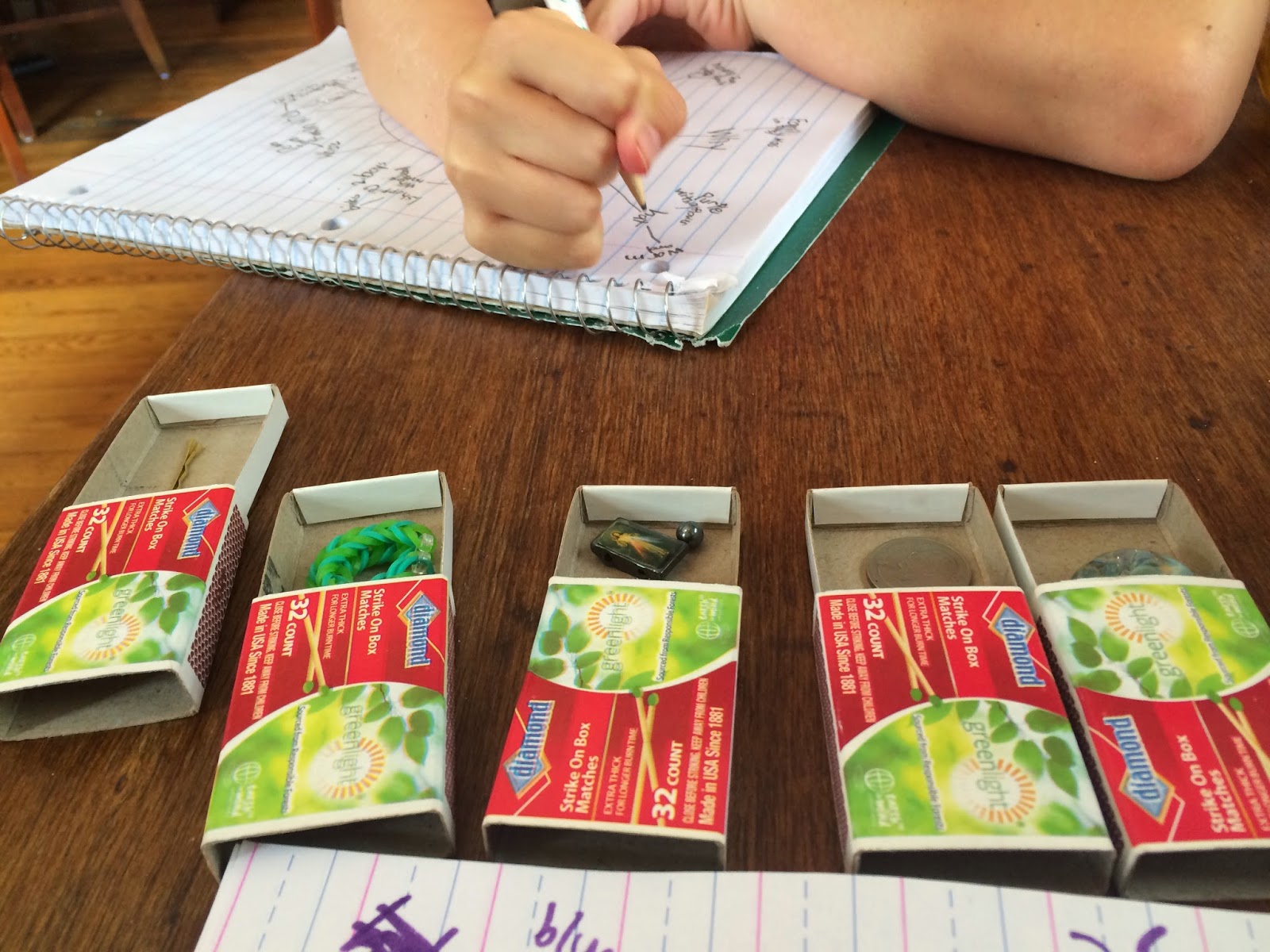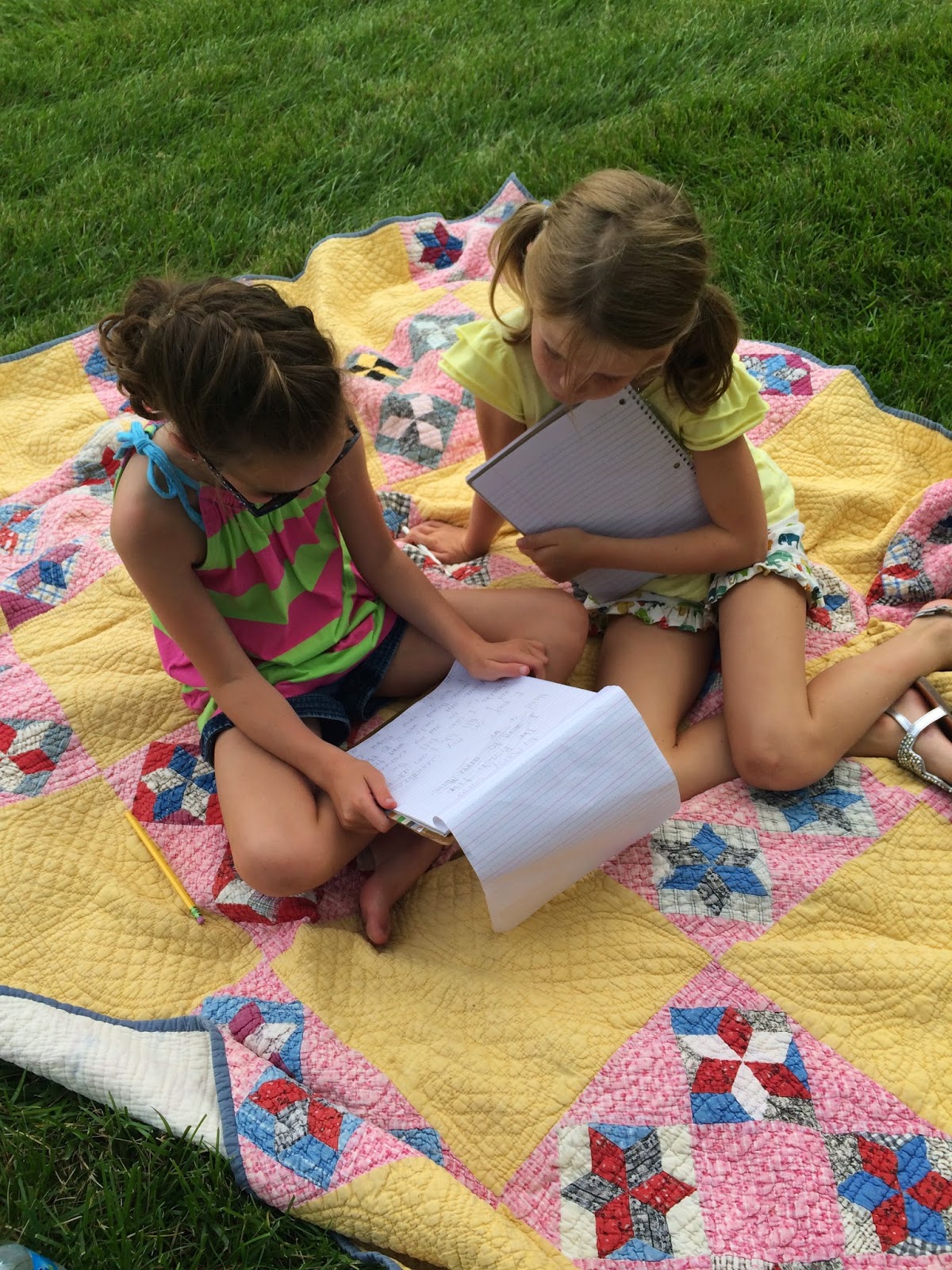The Matchbox Diary
A writer’s toughest task isn’t finding an idea but figuring out what to do with it
Materials:
·
Sharpened pencils
·
Mechanical Pencils
·
Clipboards
·
Paper
o Lined
o Handwriting
o Final copy
o Black cardstock- to mount art
o White thick paper- for art
·
Post-it notes
·
Plastic Sleeves
·
Dry erase markers-- "
·
Socks (to use as eraser)-- "
·
Sensory word list- From Jeff
Anderson book
·
Chart Paper
·
Markers
·
Cigar Box with items in matchboxes it
that I can tell stories about (i.e.
seashells, bottlecap, key, dried flower, ticket stub, ring, marbles, (non-item
like a paper clip)etc.)
·
Oil Pastels or watercolor
·
Painter’s Tape
·
Report covers
Before--- students bring in 5 items that have memories. I sent this note as apart of their homework:
Special Assignment!
We
will begin writing
narratives in class for the next few
weeks. Writer’s write about what they
know. As a writer, please bring in 5
small items that trigger a memory or something important that has happened in
your life. Bring items such as a small
seashell, concert ticket, bracelet, pin, medal, coin, etc. All of these items should fit in the attached
plastic bag.
Please bring your 5 items Monday.
Please bring your 5 items Monday.
Day 1:
Brainstorm, First Draft
Bring in personal Cigar Box, set it and book on
the table.
On a chart paper-- write LITERACY
Ask class what it is to them. discuss in groups-- ask the following questions as necessary.
Literacy—what does it mean? What does
it look like? How do you engage in literacy? Does being literate really only
mean creating meaning from the symbols known as alphabetic letters and
characters? What about reading symbols or visual images that are logos or are
in advertisements? What about reading wordless picture books? Most of all, who
gets to define what literacy is or isn't?
The field of literacy has actually
been pushing for quite some time against traditional definitions that are
limited to reading and writing, but what do your students think? Create sticky
notes on chart paper. Talk about responses and emphasize that literacy is to CONNECT through writing, stories, and pictures.
Background Info---historic information
about immigration, Ellis Island, America in the early 1920’s, or Italy, the
great-grandfather’s country of origin. Ask students what they know about Ellis Island, show a picture of the statue of liberty. Talk briefly about what it means to be an
immigrant. Discuss some of the
reasons people have for leaving their homeland, sometimes in the face of
danger, to live in a new country.
Ask who keeps a diary or a journal. Why do they keep one? What's in their journals? Is it just words? What's the importance or value of a journal/diary?
Begin reading about half of the book, then
paused to do a quick review—What object did the girl choose to have her great-grandfather tell
her about? What was inside the cigar box? Why did great-grandfather keep his
diary in matchboxes and not written in a book? What was in the first box she
opened? What is the story of the olive pit?—before
finishing the book.
Open my box, pass out boxes and let
the kids open them. Begin telling story
of 1 or 2. Then get to the paperclip
The object in box is my paperclip. I
use paperclips all the time. They are really useful. I use this one to hold
papers together.
Wait for reactions. Clearly not a story. So I ask
group what more they wanted to know—perhaps if they asked me some questions, I might find the paperclip’s
story. Where did you get it? What makes it special? How long have you had
it?
Reach for
another box. Begin telling the
story. What else do they want to
know- what does my story need to feel complete? Being making a list of what a story must entail.
In groups
of 2-4 have students share items in their boxes. Ask them and their groups to decide which item has a story they want to tell the most.
Close by sharing what item they think they will share about and what memory it holds.
Day 2: First Draft/Graphic Organizer
Read Wilfred Gordon by Mem Fox
What brought about the memories? Did they have to have words?
Model writing your first draft with one of your items. Talk aloud using a bubble map to retrieve all of the important details-- Where was I? Who was I with? What were we doing? Why? What happened? How did I feel?
Give students to brainstorm about their item in their writing notebooks.
Take a
picture of them with their item in their hands.
Closing: Share about how using the graphic organizer helped with their memory. How did they sort it? What helped organize their thoughts or get the most detail?
Day 3: First Draft Writing
Read Art & Max
--- What happened to the characters? -- emphasize that you can change the form, add details, mix things up, and still have your original idea. Sometimes starting again or looking things from a different perspective creates something better.
Share with
them my story
The Moose Story
i was walkin. I was walking by myself. It was late at nite. I had to go to the bathroom. I got on my bik. It was foggy. I saw a baby moose. I heard a loud noise behind me. A moose was
running to me. I was scared. I looked for help. i kept riding. I went through the forest. I fell. I stayed there until she left. I rode back fast!
Write suggestions on chart paper. This becomes our checklist of features to
include in our writing.
Details, sentence variety, figurative
language, capital letters, punctuation, opening sentence, closing sentence,
spelling, voice/point of view, transition words, adjectives
Review
dialogue marks. Pass out sensory words
sheet for descriptive words. (can find online if don't have Jeff Anderson book)
Model writing my own story with an item from my box in front of them. Think out loud and look to my graphic organizer for details.
Give students time to write their story. Share with a friend what they have written so far.
Day 4: Finish First Draft/Revisions
Read Chester Emphasize that the writer has the power! Whoever has the pen decides what happens. There's power in what they write. When we share writing we want it to be whole and complete and that sometimes another set of eyes can help strengthen us. Re-read the moose story from the day before--- ask them to give me a strength--- something I did well. Then, a teaching point--- something to work on. Show them how to write this on a sticky note-- star for strength, circle for teaching point.
Give students time to finish first drafts. When they are ready meet with a friend and on a sticky note write strength and teaching points. Students can also put their writing in clear plastic sheet protectors to give additional specific editing marks. I like using the sheet protectors so that it doesn't mess up the authors writing or distract-- or on the off chance the edits aren't right. :)
Revise on that paper or start a 2nd draft.
Day 5: Revisions and Editing
Read "Little Red Riding" ---finish
reading/editing with 2 friends.
As students finish their revision they meet with teacher to conference and revise. Pass out final draft paper as they finish with drafts. Give mechanical pencils.
Day 6: Finish final drafts and create art piece to go with it.
Read The Secret Box
Teacher models sketch and art of item or memory.
Sketch out ideas of item on post it- or small piece of paper. Approve with me and then give oil pastels or watercolors and
small squares to draw. Put in report covers, bind, etc.
In my 2nd Grade Class I had them paint with watercolor and I introduced strategies for using the paint. They were really easy and turned out amazing. We matted them on place pieces of paper and hung them in the hall above their writing.
Share and celebrate!!!















No comments:
Post a Comment